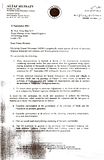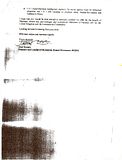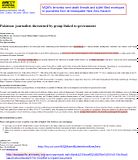MQM's leaders had been shying away from media and news talk shows ever since return of governor sindh Ishrat Ibad and explosive press conference by Zulfiqar Mirza.
Just yesterday Babar Ghauri showed up on ARY's Fahad Hussain's programme and he too got nailed by him on the issue of infestation of Abbasi Shaheed Hospital by MQM's unit terrorist who have completely invaded it and where injured pakhtuns are not allowed to be treated whenever MQM starts its killing spree and target killings and arson attacks against Pathan owned businesses intensify . Many injured Pathans from Pakthun localities like Banaras,kati Pahari,site Qasba etc loose their lives while being shifted to government hospital coz closest govt hospital Abbasi Shaheed is off limits to them during violence .
MQM's terrorist also hijack ambulances and don't allow them to pick and shift wounded pathans.
Ethnic divide hits city hospitals
KARACHI, March 23: While parts of the city have been in the grip of ethnic violence once again for the past many days, it is observed that the victims of targeted attacks as well as patients belonging to certain communities were usually not taken to the nearest government hospital.
The alarming trend where people with a certain ethnic background avoid some hospitals even if they are in a precarious condition has developed over the years, though it becomes noticeable during spates of ethnic killings and violence that the city often witnesses.
“Yes, there is a clear pattern that Pakhtun victims of targeted attacks are not taken to the Abbasi Shaheed Hospital for treatment; they even don`t allow the bodies of targeted killing victims to be taken to the ASH,” said a senior official of the medico-legal section of the Sindh government on the condition of anonymity.
The official cited the recent killing of ANP general secretary of district west Advocate Mohammad Hanif Khan, saying that the victim was attacked in SITE`s Metroville area but was taken all the way to the Jinnah Postgraduate Medical Centre, where he was pronounced dead.
A senior doctor of the JPMC also confirmed the pattern, saying that the JPMC received patients, including those with gunshot wounds, from as far as central and west districts of the city.
“There have been several instances where the body of a targeted killing victim was shifted to the Abbasi Shaheed Hospital mortuary but the heirs took away the body to another hospital,” charity workers said.
Ambulance workers know
Senior official of the Edhi Foundation Anwer Kazmi also confirmed to that the trend had been in evidence for the past many years. He said people belonging to a certain community avoided going to some hospitals.
“Now even ambulance drivers have learnt as to which hospital the body of a victim from a certain ethnic background should be shifted,” Mr Kazmi said, adding that in case a friend or relative of the victim was present at the time of shifting the driver acted on their advice.
“Generally people belonging to the Pakhtun community go to the Jinnah Postgraduate Medical Centre for treatment, while those belonging to the Urdu-speaking community by choice visit the Abbasi Shaheed Hospital,” he said.
Former President of the Pakistan Medical Association Dr Habibur Rehman Soomro confirmed the trend, saying that certain ethnic communities avoided visiting some hospitals.
“Everyone is witness to this alarming trend but no one is ready to point it out,” he said, citing the air of mistrust prevailing in the metropolis.
He said the practice was followed not only by the Pakhtun community, but also by people from other ethnic backgrounds. He explained that if there was a conflict going on between the Urdu-speaking and Sindhi-speaking people, the Sindhi-speaking people would avoid visiting certain hospitals.
The former PMA president said that the trend had been there for the past 10 to 15 years. He went on to say that certain private-sector hospitals were also following such a trend and were offering community-based services.
Just an impression
However, Sindh Health Minister Dr Saghir Ahmed dispelled the impression that Pakhtuns avoided going to the Abbasi Shaheed Hospital for treatment.
“A visit to the hospital would show you that the Pakhtuns are under treatment at the Abbasi Shaheed Hospital,” he said. He added that if statistics from the police surgeon office were examined, they would also dispel this impression. “There may be an impression, but it`s not true in reality,” he insisted.
http://www.dawn.com/2011/03/24/ethnic-divide-hits-city-hospitals.html
Intimidation hits ambulance work
KARACHI, July 14: The noble work of saving lives has become more challenging than ever for ambulance staff due to the intimidating atmosphere that prevails in the city every time it descends into violence, officials of private ambulance services told Dawn on Thursday.
Ambulance staff worked in life-threatening conditions as the city witnessed lawlessness after every few days, the officials said, adding that there was a dire need to introduce a central command and control system in this situation as well as to educate the masses about the standard operating procedures of medical emergency services.“Aman Foundation has been receiving an increasing number of complaints about intimidation and pressure tactics by patient attendants,” said Athar Jamal, head of medical emergency services of the organisation, while sharing his concerns over the current situation.
“The security of the ambulance and its staff is as vulnerable as it is of the common man. The staff is often forced to violate the standard operating procedures (SOPs) at gun-point. In one or two instances, the personnel were beaten up for not following `orders`. The ambulances were either targeted or caught in the crossfire,” he said.
He explained that the SOPs included that requests were attended through a special number and that ambulances were not used to transport bodies.
“Our fleet of over 100 ambulances is equipped with state-of-the-art life-saving apparatus. The 1,000 plus staff include male nurses and doctors. Even drivers are trained in basic life support system. Hence, our focus is to utilise our resources to save a life rather than using them for transporting a body. For this, other vehicles are available,” he explained.
Recalling the recent Kati Pahari violence in Orangi Town, he said the staff was forced not to attend the wounded victims of rival group. “Also, the staff belonging to one ethnicity was afraid to work in an area dominated by people of another ethnicity,” he said.
Unfortunately, staff`s experience of police even was not good, said Mr Jamal, while highlighting the need for special instructions to the law-enforcement agencies to facilitate ambulance service.
Speaking about other difficulties the staff faced, he said that a major problem was encountered during violence when the staff on another shift failed to reach on time. “In this situation, the staff already on the job is required to continue work and wait till the new team takes over,” he said.
Sharing similar views with Dawn, Chippa Foundation head Ramzan Chippa said the staff was often bullied and there were instances when drivers were beaten up.
“People must show respect to those who are there to save a life,” he said. Threats and fear could only cause harm, he added.
When asked, Anwar Kazmi of the Edhi Foundation didn`t complain about the security of ambulance staff though he did highlight the need to regulate the various ambulance services of the city. He said that his organisation was ready to join in any such effort.
“The government had taken an initiative in the recent past in this regard and a few meetings were also held. But, I am not certain about the current status of those efforts. Performance of emergency services especially in times of disasters would definitely improve if all relevant organisations work under an umbrella,” he said.
http://www.dawn.com/2011/07/15/intimidation-hits-ambulance-work.html






